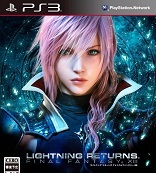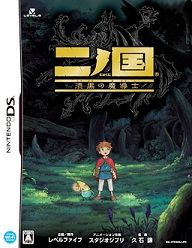Lightning Returns: Final Fantasy XIII (Japan Import)
PlayStation 3
Reviewed: 2/1/2014
Taking place 500 years after the end of Final Fantasy XIII-2, Lightning Returns gives players the chance to control Lightning and only Lightning as she takes on the role of Savior. Recruited by the god Bhunivelze to help save souls and usher in a new beginning, she returns to a world that is now warped by Chaos, hoping to succeed at her task so that Sarah’s soul might be reborn in a newly-created world after the final thirteen days.
For a saga that themed its story around breaking free of cruel fates, Lightning Returns proves that the Final Fantasy XIII characters really can`t escape the same fate time and time again–their fate at the hands of the writers, not the infighting gods of the story`s canon. Even though the setup is much different, the same situations are getting retread: developmentally, Lightning is at the same place she was when Final Fantasy XIII started, and is doing similar things, as are the rest of the cast members. She`s trying to save her sister and fighting against a cruel fate, while stifling her inner emotions because she thinks that will make her stronger. (Fortunately, Lightning has gained a little bit of genre-savviness during her long sleep, and she spends most of the thirteen final days of the world snarking at NPCs as they offer her quests.) Two characters have changed their tune a little: Vanille is resigned to a grim fate rather than trying to run from it, and Snow is uncharacteristically defeated and grim, but since both characters were practically absent from XIII-2, these changes feel like they were manufactured to create capital-D Drama, rather than natural progressions of character arcs.
During the main game, the impact of the manufactured drama isn’t too severe because the player can set the pace at which to proceed and the story scenes aren`t too numerous, but as soon as the final day hits, beware. Any progress that characters made, any function that they served, any personality that they had evaporates as the story turns into a gaudy, super-staged finale, where characters fly facefirst through space multiple times, bid each other goodbye, and then emotionally reunite almost immediately, or take each other’s hands dramatically.
It’s as though the writers were trying to squeeze every last drop of drama from the characters and setting, and so every chance for a cliffhanger, a cool pose, a standoff, or a heartfelt goodbye is taken — and taken to the extreme. Fans of the FFXIII cosmology will be disappointed as the story behind the deities is barely touched upon and makes less sense than before, leading up to a final boss encounter of the sort we`ve seen a hundred times. As the icing on the cake, the ending breaks the fourth wall in a very, very silly way. Even taking into account the shaky foundation the story had coming into Lightning Returns, it feels as though the tale hits new lows, repelling players with its over-the-top, recycled grabs for attention even as it pleas “This is cool! Look how dramatic it is! Please be excited!”
The past two Final Fantasy XIII games had other charms that helped fill the void left by the bizarre story, but Lightning Returns is the sloppiest of the Final Fantasy XIII games in almost every regard. The previous two games had linear but well-balanced progression and entertaining battle systems that stayed fun throughout the duration of the game. Lightning Returns takes far more risks, and while it has a heart-pounding battle system and some of the most fun individual moments in the XIII saga, it also makes critical mistakes that cripple it in the long-term. The unique premise of the game and the incredible potential that players glimpse while playing it makes the game’s failure to follow through even more disappointing.
In Lightning Returns, time is supposed to be the ultimate factor guiding the player’s decisions. With only thirteen days in the game, all other things that must be rationed–money, HP, Glory Points, items–can be distilled down to a cost in time. The player is drilled with the impression that not only will Lightning Returns be difficult (the game itself and the developers both have spent a lot of energy pushing players to try Easy Mode first), but that the given time limit will force hard decisions: this quest or that quest, save money or spend it now, risk fighting tougher monsters or exterminate easier ones. Hope even says multiple times in-game that not everyone can be saved, and that every moment should be spent thinking about how to spend time wisely. The game encourages players to be over-cautious, which has a side-effect of countering the benefits of its wide-open explorable world: when a clock is ticking down every three seconds and characters keep telling the player to spend time wisely, it sucks some of the fun out of exploring every nook and cranny of the wide maps, and indeed adds some stress to what should be the fun of discovery. The anti-climax is that, even for a rookie on Normal mode, it’s possible to finish all the story quests before the halfway point, and all but the most broken sidequests with days and days to spare. The final days have almost nothing to fill them.
Progression withing Lightning Returns is capped in a way that feels limiting, further hampering the non-linear world the developers were trying to create. Lightning now only may get stronger by completing quests, by getting new equipment, or by improving her abilities. Shops will only cough up their stronger inventory on later days in the game, even if the player is rolling in money. The number of quests by which Lightning may get stronger is finite, which isn’t unreasonable, but the rewards for quests often don’t seem to match the effort put into them. The worst offender is the ability fusion system. Abilities of the same type and level may be fused together to improve their strength and effectiveness, and coming by multiples of the same ability is difficult enough that it’s a reasonable way to limit progression; however, abilities may only be leveled up with items, and some of those items are not even available outside of Hard Mode. This wouldn’t be a problem, but Hard Mode is only unlocked after completing the game on Normal. Upgrading equipment is also limited to a second playthrough, for no apparent reason. The result is that, despite the game being sold as more open, character progression still feels forced into a narrow box of possibilities.
The terrible pacing and progression don’t do the battle system any favors, which is a shame because Square Enix has come up with a one-party-member ATB system that is fast, skill-based, and exciting, if a little button-mashy after a time. Lightning may equip up to three outfits with configured skills and buffs, called Styles, and each Style has its own ATB bar which fills at a certain rate. Pressing a face button will execute the corresponding skill and deplete the ATB bar by a fixed amount per skill. Certain skills have a chance of pushing an enemy closer towards Knockout status, where they are more vulnerable to damage and often acquire negative status effects. Guarding attacks right before the impact increasing Lightning’s defense further than guarding far in advance of an attack. Juggling skills that have a chance of knocking out enemies, skills that deal big damage, and guarding enemy attacks, all in real time, is exciting and places more emphasis on execution than strategy. Special moves that use rare Glory Points can freeze time, heal Lightning or knock out enemies.
When LR: FFXIII‘s battles are at their best, primarily during the four story quest bosses, they are among the most engaging in the series. A battle with a villain from one of the previous two games strikes a sublime balance of fast and slow attacks, powerful elemental blasts, and a form change that alters the player’s knockout strategy. That single fight is perfect, favoring both aggressive and defensive play styles and intense enough to make one’s palms sweat. Had the whole game been fights like that, many other flaws could be forgiven, but Lightning Returns has too many easy fights where the strategy is formulaic. The enemy numbers are mostly finite, and enemies can be exterminated entirely, but there are still just too many of the same enemies.
Presentation, too, is marred by problems. Its graphics are acceptable, despite textures not looking as nice as the Final Fantasy usual. Environments are well-designed and look wonderful, but the camera during conversations and cutscenes will pan around at awkward angles. For example, Lightning might be talking to an NPC and the camera will slowly pan into a low-res bush. Wandering NPCs into towns have various actions and animations they can perform that usually make sense, like browsing shop wares or clapping and cheering for fireworks, but sometimes they do things like clap and cheer in front of a murder victim, or congregate in an empty back alley. Wandering NPCs can also crowd into the frame, block the camera or even push Lightning or other NPCs around during cutscenes.
As far as soundtracks go, Lightning Returns trends closer to Final Fantasy XIII‘s style of compositionally solid but bland music, rather than XIII-2‘s divisive collection of catchy, but often irritating tunes. Not only does its soundtrack clock in at over five hours, but it also borrows the best tunes from its predecessors, so there really is something here for fans of either style. The soundtrack excels at the atmospheric background music for each of the game’s four maps, which changes according to the time of day or other factors. Sound effects aren’t too special outside of battles, but inside battle they’re used very effectively, cueing the player to the tide of the fight.
Lightning Returns: Final Fantasy XIII is the sum of many disparate parts. It has strong core gameplay elements, but these are weakened by poor pacing and balance. It tries to allow the player more freedom, but seems to have been made without an understanding of how to deliver what players want when they say they want a less linear experience. Its story wavers throughout the game and caps off the Final Fantasy XIII saga in possibly the hokiest way possible. There are excellent moments within the game, and exciting battles, but also a lot of undelivered potential that is sure to disappoint players who are excited by the idea of a Majora’s Mask-like premise. In the end, it doesn’t have enough content to fill the time it gives the player and drags on long enough for even its best components to start losing their luster. If the Final Fantasy XIII saga ends here, given the trajectory of the first game to the last, it’s probably for the best.
-Janelle Hindman








